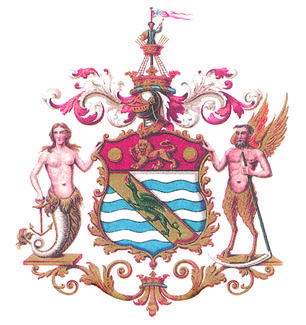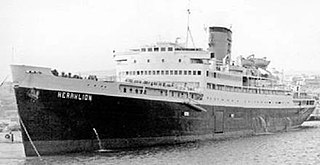Related Research Articles
Richard ap Meryk, anglicised to Richard Amerike was a British merchant, royal customs officer and later, sheriff of Bristol. Several claims have been made for Amerike by popular writers of the late twentieth century. One was that he was the major funder of the voyage of exploration launched from Bristol by the Venetian John Cabot in 1497, and that Amerike was the owner of Cabot's ship, the Matthew. The other claim revived a theory first proposed in 1908 by a Bristolian scholar and amateur historian, Alfred Hudd. Hudd's theory, greatly elaborated by later writers, suggested that the continental name America was derived from Amerike's surname in gratitude for his sponsorship of Cabot's successful discovery expedition to 'the new World'. However, neither claim is backed up by hard evidence, and the consensus view is that America is named after Amerigo Vespucci, the Italian explorer.

Porthcawl ( ) is a town and community in the Bridgend County Borough of Wales. It is on the south coast of Wales, 25 miles (40 km) west of Cardiff and 19 miles (31 km) southeast of Swansea.

Minehead is a coastal town and civil parish in Somerset, England. It lies on the south bank of the Bristol Channel, 21 miles (34 km) north-west of the county town of Taunton, 12 miles (19 km) from the boundary with the county of Devon and in proximity of the Exmoor National Park. The parish of Minehead has a population of approximately 11,981, making it the most populous town in the western part of the now-defunct Somerset West and Taunton local government district, which in turn, is the worst area in the country for social mobility. This figure includes Alcombe and Woodcombe, suburban villages which have been subsumed into Minehead.

The Society of Merchant Venturers is a charitable organisation in the English city of Bristol.

Bristol Harbour is the harbour in the city of Bristol, England. The harbour covers an area of 70 acres. It is the former natural tidal river Avon through the city but was made into its current form in 1809 when the tide was prevented from going out permanently. A tidal by-pass was dug for 2 miles through the fields of Bedminster for the river, known as the "River Avon New Cut", "New Cut", or simply "The Cut". It is often called the Floating Harbour as the water level remains constant and it is not affected by the state of the tide on the river in the Avon Gorge, The New Cut or the natural river southeast of Temple Meads to its source.

Bristol is a city with a population of nearly half a million people in south west England, situated between Somerset and Gloucestershire on the tidal River Avon. It has been among the country's largest and most economically and culturally important cities for eight centuries. The Bristol area has been settled since the Stone Age and there is evidence of Roman occupation. A mint was established in the Saxon burgh of Brycgstow by the 10th century and the town rose to prominence in the Norman era, gaining a charter and county status in 1373. The change in the form of the name 'Bristol' is due to the local pronunciation of 'ow' as 'ol'.
The Port of Bristol comprises the commercial, and former commercial, docks situated in and near the city of Bristol in England. The Port of Bristol Authority was the commercial title of the Bristol City, Avonmouth, Portishead and Royal Portbury Docks when they were operated by Bristol City Council, which ceased trade when the Avonmouth and Royal Portbury Docks were leased to The Bristol Port Company in 1991.

Matthew was a caravel sailed by John Cabot in 1497 from Bristol to Newfoundland, North America. There are two modern replicas – one in Bristol, England and one in Bonavista, Newfoundland.

Cabot was a council ward that covered the centre of Bristol, England. It took its name from the Cabot Tower, a memorial tower on Brandon Hill that was built to commemorate John Cabot's voyage and "discovery" of North America. The ward was abolished in 2016.

SS Heraklion was a roll on/roll off car ferry operating the lines Piraeus – Chania and Piraeus – Irakleio between 1965 and 1966. The ship capsized and sank on 8 December 1966 in the Aegean Sea, resulting in the death of over 200 people. Her demise was one of the greatest maritime disasters in Greek history.
The MV Sea Empress was a single-hull Suezmax oil tanker that ran aground at the entrance to the Milford Haven harbour on the southwest coast of Wales in February 1996. The ensuing oil spill, Britain's third largest oil spillage and the 12th largest in the world at the time, devastated a considerable area of local coastline and killed many birds, and continued to affect the Pembrokeshire coast for years afterwards.

The Great Bristol Half Marathon is an annual road running event held on the streets of Bristol, UK. The route is at sea level and starts on Anchor Road outside We The Curious. Participants make their way toward Hotwells before heading under the Clifton Suspension Bridge and along the Portway toward Sea Mills before returning the same way then navigating around Cumberland Basin then along Spike Island before crossing Prince Street Bridge, circling Queen Square then heading to Castle Park via St Mary Redcliffe and Temple Circus. The final mile and a half take place in the Old City and Bristol city centre before crossing the finish line back at Anchor Road.

The Bristol Harbour Festival is a festival held annually in the English city of Bristol, and which the celebrates the city's maritime heritage and the importance of Bristol's docks and harbour. Most of the activities, including live music, street performances, fireworks and a variety of other live entertainments, are held on or near the waterfront of Bristol Harbour. Venues include Queen Square, Lloyds Amphitheatre, Millennium Square and Castle Park, with seagoing vessels moored nearby. The liveliest part of the festival is quayside, but the main attractions are entertainment designed to engage all the communities of Bristol, as well as entertain the thousands of visitors to the city.

The International Festivals of the Sea were a series of maritime festivals, which were held in various British port cities between 1996 and 2005. The festivals were intended to be celebrations of the sea, bringing together sailors, musicians, artists, entertainers, ships and boats from all points of the compass.

John Cabot was an Italian navigator and explorer. His 1497 voyage to the coast of North America under the commission of Henry VII, King of England is the earliest known European exploration of coastal North America since the Norse visits to Vinland in the eleventh century. To mark the celebration of the 500th anniversary of Cabot's expedition, both the Canadian and British governments declared Cape Bonavista, Newfoundland as representing Cabot's first landing site. However, alternative locations have also been proposed.


Sundowner is a motor yacht formerly owned by Charles Lightoller, who was Second Officer aboard the RMS Titanic for her ill-fated maiden voyage in April, 1912.

A Bristol Channel pilot cutter is a type of sailing boat used until the early part of the 20th century to deliver and collect pilots to and from merchant vessels using ports in the Bristol Channel. Each pilot worked individually, in competition with other pilots. Especially after 1861, the level of competition required larger and faster cutters, as pilots went "seeking" at much greater distances. The resulting boats were known for their ability to sail in the most extreme weather, for speed and sea-kindliness. They were designed for short handed sailing, often manned only by a man and an apprentice, with one or sometimes two pilots on board.
The following is a timeline of the history of the city of Bristol, England.
References
- ↑ "Bristol Festival of the Sea 1996" . Retrieved 7 November 2012.
- ↑ "Eye of The Wind - Newsletter". WebRing Inc. Retrieved 31 July 2007.
- ↑ "File & TV Database - International Festival of the Sea". British Film Institute. Archived from the original on 1 June 2009. Retrieved 31 July 2007.
51°27′N2°36′W / 51.45°N 2.60°W